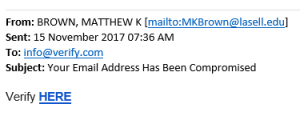We’ve had a couple of reports from personnel and students about getting messages with a subject of “Your Email Address Has Been Compromised” (notice the capitalisation of every word, which is one of the signs of phishing)
The scammers have spoofed the recipient (your e-mail address to read info@verify.com) and the sender seems to come from a compromised university account in the USA (address end with an .edu)
The subject says: “Your Email Address Has Been Compromised” and a link Verify HERE is included which takes you to a website ending with a “weebly.com”. It looks already as if the website is offline or has already been blocked by Information Technology, but you should never click on links in mail if the sender is unknown.
Keep in mind, Information Technology will never send you such a mail, telling you that your e-mail address has been compromised. All IT’s communications are bilingual and will always address you personally.
If you get mail like this and you are not sure if it is legitimate or not, you should never click links or respond but rather contact IT telephonically at 808 4367 to verify.
Information Technology will send you an automated mail IF you have changed your password on the network that is branded, is bilingual, and informs you of a password change, but it is always better to check and make sure especially if you HAVEN’T changed your password or don’t recall if you have changed your password.
Here is an example of the current phishing scam.

If you have received mail that looks like this please immediately report it to the Information Technology Security Team using the following method:
Send the spam/phishing mail to the following addresses
…and sysadm@sun.ac.za as well.
Attach the phishing or suspicious mail on to the message if possible. There is a good tutorial on how to do this at the following link (Which is safe) : http://stbsp01.stb.sun.ac.za/innov/it/it-help/Wiki%20Pages/Spam%20sysadmin%20Eng.aspx
- Start up a new mail addressed to sysadm@sun.ac.za (CC: help@sun.ac.za)
- Use the Title “SPAM” (without quotes) in the Subject.
- With this New Mail window open, drag the suspicious spam/phishing mail from your Inbox into the New Mail Window. It will attach the mail as an enclosure and a small icon with a light yellow envelope will appear in the attachments section of the New Mail.
- Send the mail.
If you did click on the link of this phishing spam and unwittingly give the scammers your username, e-mail address and password you should immediately go to http://www.sun.ac.za/useradm and change the passwords on ALL your university accounts (making sure the new password is completely different, and is a strong password that will not be easily guessed.) as well as changing the passwords on your social media and private e-mail accounts (especially if you use the same passwords on these accounts.)
Tags: phishing

